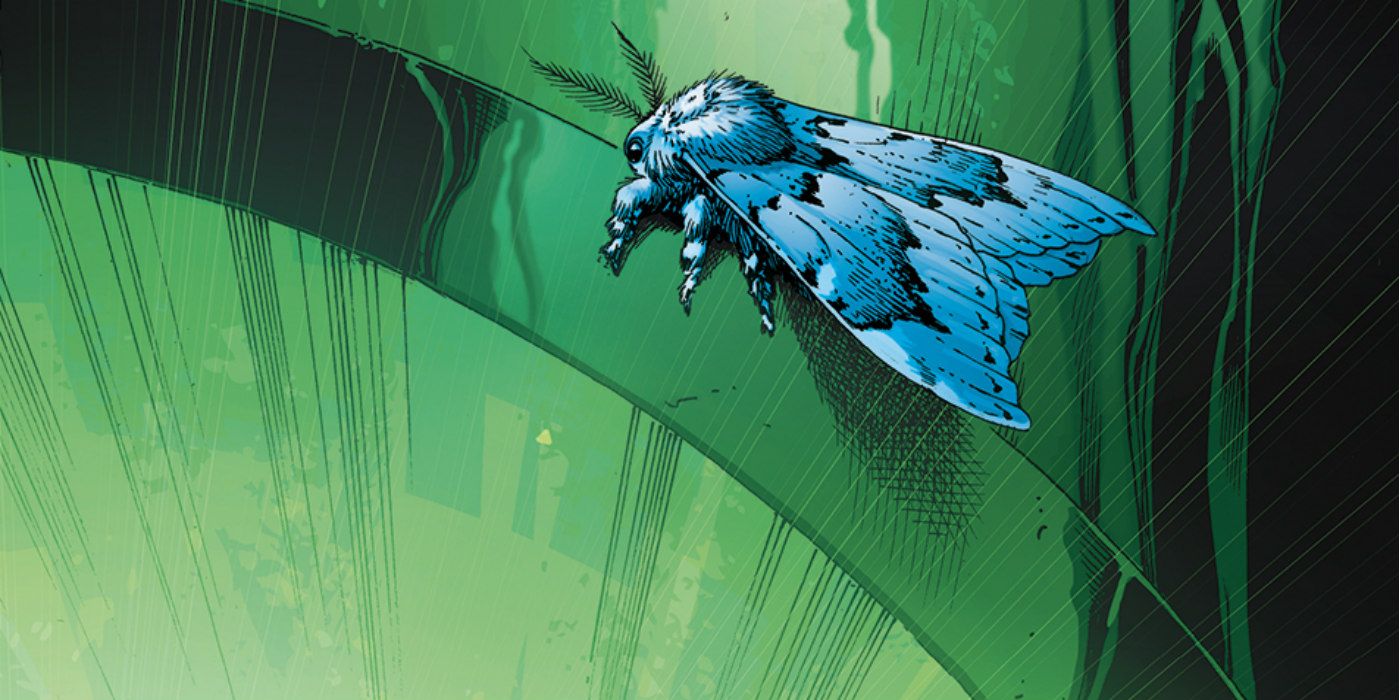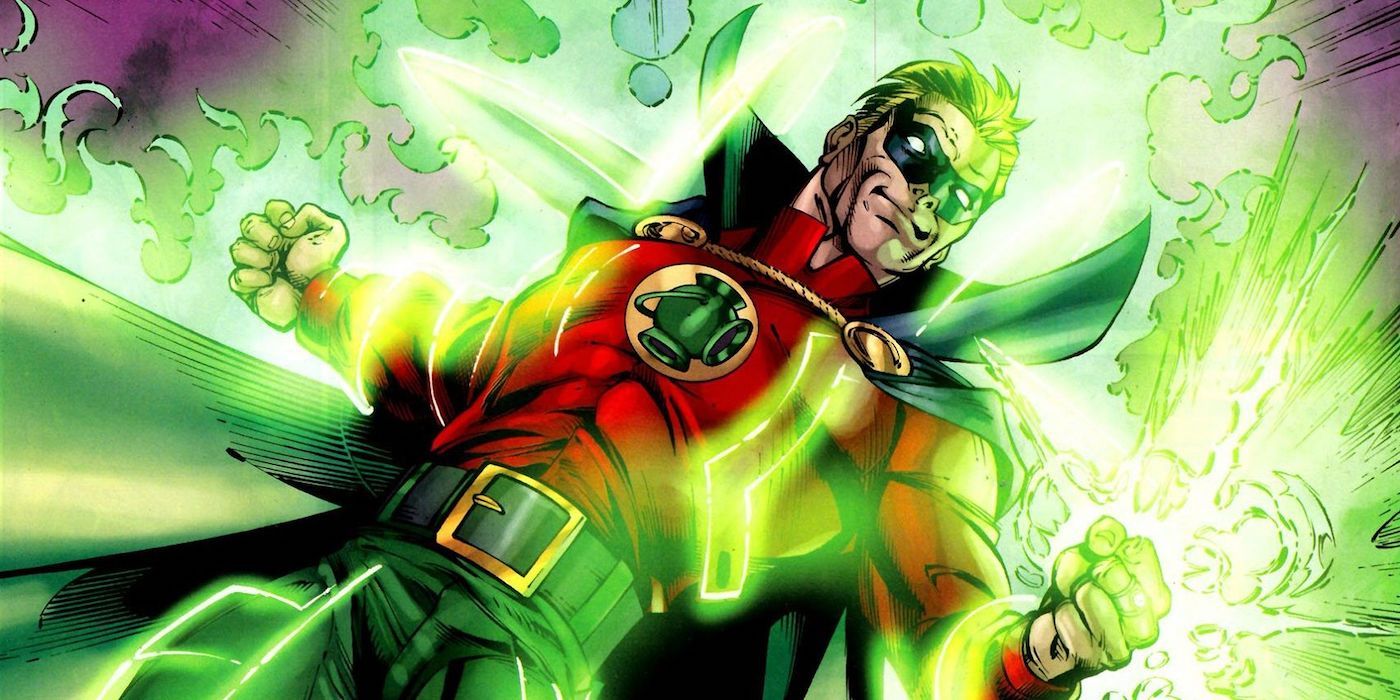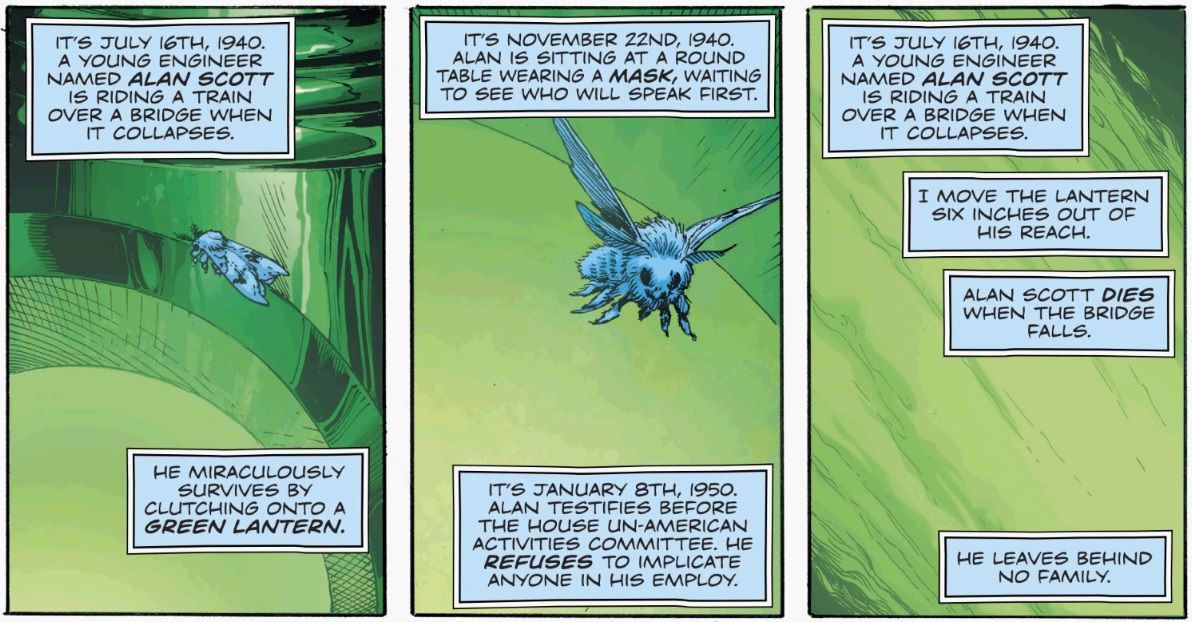WARNING: The following contains spoilers for Doomsday Clock #7 by Geoff Johns and Gary Frank, on sale now.
Doomsday Clock has been slowly leading readers toward a confrontation between Watchmen’s Doctor Manhattan and the DC Universe. Ever since the first tease in the pages of 2016’s DC Rebirth #1, we’ve known that the powerful, god-like Manhattan has been manipulating the lives of DC’s heroes in dozens of ways both big and small. Now, thanks to Doomsday Clock #7, we see another piece of the puzzle, and it looks like Manhattan’s interference may have cost us the Golden Age of comics.
As with every issue of Watchmen that came before it, Doomsday Clock’s story starts on the cover before continuing inside. On the cover, we see a close-up of a blue moth sitting on the Golden Age version of the Green Lantern itself (first seen in 1940). As we turn the page, we're given a brief recap of the origin of the Golden Age Green Lantern, Alan Scott, narrated with familiar blue caption boxes.
RELATED: Doomsday Clock #7 Gives Us the Moment We’ve All Been Waiting For
We’re told about a young train engineer who survives a bridge collapse by holding onto a mysterious lantern. Gradually, we start to see the impact that moment had not only on Alan Scott, but on the burgeoning superhero community of the era. Then, Doctor Manhattan's narration tells us of a small moment, an almost imperceptible change he makes to the timeline. As a result, Alan Scott dies in the very train accident that once elevated him to the status of global hero.
First appearing in All-American Comics #16 from 1940, Alan Scott was created by Bill Finger and Martin Nodell as the very first hero to bear the name Green Lantern. Unlike his sci-fi space cop successor Hal Jordan, Scott more closely resembles a mythical, magical hero that is granted superpowers from a lantern.
There are familiar elements that you would recognize in modern Green Lantern comics, like the powerful emerald ring that Alan wears, although the power set is somewhat different. The origins of both Alan Scott and the lantern itself are fairly faithfully retold on the first page Doomsday Clock #7. That is, until Doctor Manhattan gets involved.
The story of the Golden Age Green Lantern starts with a mystical flame that falls to Earth in ancient China. A local lampmaker hears a voice from the green metal within the fallen meteor that tells of three times it will flame green: once to bring death, once to bring life and the final time to bring power. As the man crafts the metal into a green lamp, he is killed for his sacrilege, fulfilling the first prophecy.
Page 2: [valnet-url-page page=2 paginated=0 text='Doctor Manhattan’s Meddling Has Created A Whole New DC Continuity']
Fast-forward to 1940 and a patient in a mental hospital comes upon the lamp and refashions it into a modern train lantern. This act grants him his sanity, allowing him to walk free and reclaim his life. With the second part of the prophecy fulfilled, the lantern ends up on the same train as Alan Scott, ready to complete its third promise -- one of power.
As the train that carries Alan Scott derails from a bridge collapse, the young engineer clings to the mysterious green lantern. Not only is his life saved, but he is granted unbelievable powers that transform him into the Golden Age hero Green Lantern. Except now, in Doomsday Clock #7, Doctor Manhattan makes a subtle change to history.
As the bridge collapses around Alan Scott, Manhattan moves the lantern six inches out of his reach. Unable to grasp the object that grants him his overwhelming gift, the young engineer dies in the accident and the Golden Age Green Lantern is erased from history.
As we read through Manhattan’s narrative, we see history shunted down a different path. Instead of testifying in front of the Joint Congressional Un-American Activities Committee, we hear that Alan Scott's death leaves behind no family. Instead of accompanying Alan Scott into a life of a superherodom, the lantern is recovered from the train wreck and discarded into a scrap heap.
RELATED: Doomsday Clock May Have Revealed Why There is No JSA in Rebirth Continuity
Perhaps most shocking of all, Alan’s death prevents him from becoming a founding member of the Justice Society of America, and as Doctor Manhattan talks of running his fingers through the dust on a familiar round table, the implication is obvious: Without Alan, the Justice Society and the Golden Age of superheroes is also erased.
It has been clear since DC Rebirth #1 that Doctor Manhattan has manipulated the DC Universe in many ways. One of the first examples concerned the original Wally West, who had been lost into the timestream thanks to the powerful Watchmen character’s influence. Now, we can see that his small changes have influenced the universe in ways we cannot fathom. Like a moth beating its wings and causing a hurricane somewhere across the world, Doctor Manhattan's effect is small but devastating.



